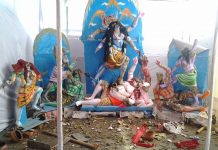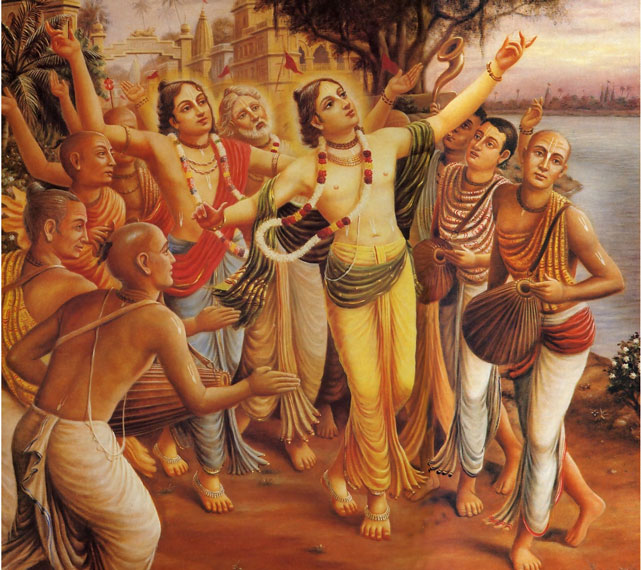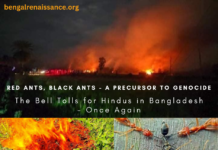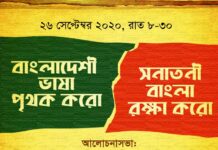
Chaitanya Mahaprabhu has composed not a single verse in Bengali. So apparently his contribution to Bengali literature seems to be nil, right? Still his influence in Medieval Bengali literature remains undeniable. His groundbreaking arrival brought a great renaissance in the society and culture of Bengal. This redirected the path of traditions in Bengali literature. Freedom of the defeated mind under the foreign Islamic rules and emotions of love and humanity underpinning the Hindu heart to move towards salvation created new values and directions of life following Mahaprabhu’s footsteps.

In the following, we will show the direct and indirect influences of the saint in Bengali literature.
| Direct influences:
|
Vaishnav Padavali | The entry of spiritual relationship in the place of prior material love of Radha Krishna gave fresh and detailed interpretations of the entire Padavali literature. Moreover, new sections of Padavali, namely “Gaurchandrika” and “Gaur Padavali” were dedicated to the life of “Gaurchandra” or Chaitanya. |
| Biography of Chaitanya | The “Chaitanya Bhagavat” by Vrindaban Das opened the new trend of biopic considering the Godly character of Mahaprabhu. Here, later examples of Chaintanyamangal by Jayananda, Chaitanya Mangal by Lochan Das and Chaitanya Charitamirta of Krishnadas Kaviraj revealed new paths towards the change. | |
| Indirect effects: | Mangal Kavya | The narrow-mindedness, brutality, cruelty and selfishness of various Gods and Goddesses of Mangal Kavya in Pre-Chintainya era diminished a lot and transformed into more Godly, pleasant and divine glory. For example, the development of natures of of vengeful Chandi into Mother Avaya (one who assure protection) in the hands of Mukunda Chakravarty and Dwija Madhav and kind image of Dharam Thakur in Dharma Mangal Kavya, can be considered. |
| Translations | The social, cultural ambience and characters from Ramayana, Mahabharata and Bhagavata in the Bengali language under the influence of Vaishnavism are the instances worth mentioning here. | |
| Shakta Padavali | Some argue that the versus that signified the love for children or Vatsalya Rasa and Uma Sangit (Songs of Mother Uma) like Agamani and Vijaya songs faced changes due to Chaitanya’s cordial and polite teachings. | |
| Folklores | Here, the effect of Chaitanya is strong. The instances of Mymensingh Geetika, the collection of folk ballads from Mymensingh, Bangladesh and most notably the Baul school of thought and music, searching for the “Moner Manush” (the correct person to love in mind) are finest epitomes. |

Thus, the previous indelicacy, beastliness and vulgarism in the lines changed into like what they say “Debotare priyo kori, priyore kori Debota” (Making God the beloved one and the lover my God).

আমার নিতাই চাঁদের বাজারে
গৌর চাঁদের দরবারে
একমন যার সেই যেতে পারে।
আবার দুই মন হলে পড়বি ফাঁদে
খ্যাপারে-
আবার দুই মন হলে পড়বি ফাঁদে
ওরে পারবি না পাড়ে যেতে।
Amar Nitai Chader bazare
Gour Chader dorbare
Ekmon jar sei jete pare
Abar dui mon hole porbi faade
Parbi na pare jete (Song of Bhaba Paga)
In the assembly of my Nitai Chand
At the court of my Gour Chand
Only who has one/assured/determined mind can visit
If you are in doubt or two-minded, you are in the trap
You will not reach the shore!
Content courtesy:
চৈতন্য মহাপ্রভু ও মধ্যযুগীয় বাংলা সাহিত্য
Image courtesy:
https://www.iskconvapi.com/photo.php?f=16
https://www.quora.com/How-did-Chaitanya-Dev-Mahaprabhu-die
https://www.facebook.com/181703271675/photos/wow-a-real-portrait-of-sri-chaitanya-mahaprabhu-how-amazing-and-how-beautiful-th/10154834631456676/
https://iskcondesiretree.com/profiles/blogs/namacharya-srila-haridas




































